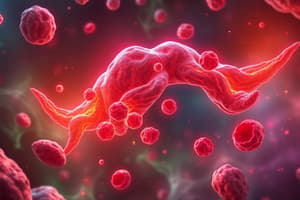Podcast
Questions and Answers
What is indicative of megaloblastic anemia as seen in blood films?
What is indicative of megaloblastic anemia as seen in blood films?
- Increased platelet count
- Presence of oval macrocytosis (correct)
- Decreased white blood cell count
- Normal red blood cell morphology
Which test can help detect abnormalities that precede symptoms of cobalamin or folate deficiency?
Which test can help detect abnormalities that precede symptoms of cobalamin or folate deficiency?
- Plasma Methylmalonic acid
- Serum folate levels
- Total Homocysteine levels (correct)
- Complete Blood Count (CBC)
What is a limitation of serum folate measurements in diagnosing deficiency?
What is a limitation of serum folate measurements in diagnosing deficiency?
- They can only measure active forms of folate.
- False positive and negative results can occur. (correct)
- They are consistently accurate for all patients.
- They do not require clinical context for interpretation.
What condition may affect plasma Methylmalonic acid levels aside from cobalamin deficiency?
What condition may affect plasma Methylmalonic acid levels aside from cobalamin deficiency?
Why should results from cobalamin and folate tests be interpreted with clinical context in mind?
Why should results from cobalamin and folate tests be interpreted with clinical context in mind?
Which type of deficiency can cause an increase in both Total Homocysteine and Plasma Methylmalonic acid?
Which type of deficiency can cause an increase in both Total Homocysteine and Plasma Methylmalonic acid?
What is a possible cause of macrocytosis that must be considered in differential diagnoses?
What is a possible cause of macrocytosis that must be considered in differential diagnoses?
What role does cobalamin deficiency play in interpreting serum folate results?
What role does cobalamin deficiency play in interpreting serum folate results?
What is recommended when administering treatment for cobalamin or folate deficiencies?
What is recommended when administering treatment for cobalamin or folate deficiencies?
Flashcards
Oval Macrocytosis
Oval Macrocytosis
Red blood cells are abnormally large, with oval shape. Found in megaloblastic anemias due to Vitamin B12 (Cobalamin) or Folate deficiency.
Hypersegmented Neutrophils
Hypersegmented Neutrophils
A common finding in megaloblastic anemias, where neutrophils have more than 6 lobes in their nucleus. Indicates severe B12 or Folate deficiency.
Serum Cobalamin
Serum Cobalamin
This test measures both inactive and active forms of Vitamin B12 in the blood. It's helpful to see the overall B12 levels in the body.
Total Homocysteine
Total Homocysteine
Signup and view all the flashcards
Plasma Methylmalonic Acid
Plasma Methylmalonic Acid
Signup and view all the flashcards
Serum Folate
Serum Folate
Signup and view all the flashcards
Cobalamin Deficiency Complicates Folate Interpretation
Cobalamin Deficiency Complicates Folate Interpretation
Signup and view all the flashcards
Megaloblastic Anemia Morphology
Megaloblastic Anemia Morphology
Signup and view all the flashcards
Interpreting B12 and Folate Test Results
Interpreting B12 and Folate Test Results
Signup and view all the flashcards
Megaloblastic Anemia Treatment
Megaloblastic Anemia Treatment
Signup and view all the flashcards
Study Notes
Megaloblastic Anaemia Investigations
- Megaloblastic anaemia is diagnosed through a range of tests, including full blood counts (FBC) and blood films.
- FBC and blood films show reduced sensitivity in the early stages of deficiency.
- Oval macrocytosis and more than 3% hypersegmented neutrophils (greater than 6 lobes) are key indicators of megaloblastic anaemia.
- Other potential causes of macrocytosis must also be assessed.
- Serum cobalamin and folate levels are measured to identify deficiency, but results may be confounded by false positives and negatives, or complexities in interpretation.
- Tests for inactive forms of cobalamin (transcobalamin I and holohaptocorrin) and active forms (holotranscobalamin) are both conducted.
- Total homocysteine levels are often elevated in both cobalamin and folate deficiencies, and may be an early indicator.
- Methylmalonic acid levels are elevated specifically in cobalamin deficiencies, although renal disease or gut bacterial overgrowth may affect these results.
- Serum folate levels have limitations with false positive and false negative results, compounded by cobalamin deficiency potentially interfering with folate interpretations.
- Cobalamin and folate measurements are often conducted together in response to clinical suspicions.
- Interpretation of results involves considering the clinical context of the patient.
- Treatment should comply with British National Formulary (BNF) guidelines.
- Complex interactions between biochemical findings can complicate interpretations.
- Grey areas between normal and abnormal results can be challenging to resolve.
Studying That Suits You
Use AI to generate personalized quizzes and flashcards to suit your learning preferences.
Related Documents
Description
This quiz covers the diagnostic tests used for identifying megaloblastic anaemia, including the significance of full blood counts and blood films. It also discusses key indicators such as macrocytosis, hypersegmented neutrophils, and the roles of serum cobalamin and folate levels. Participants will gain insights into interpreting various test results and understanding potential confounding factors.




